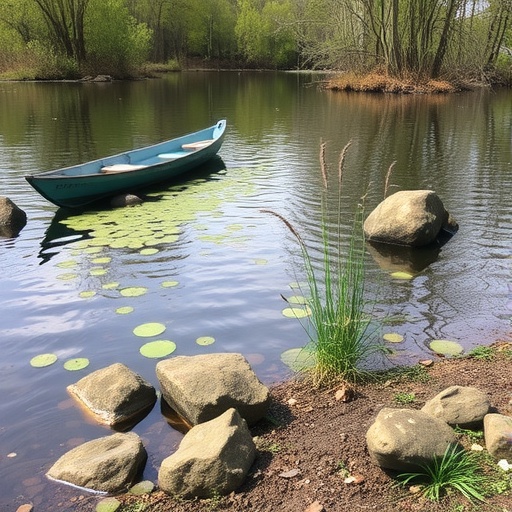In recent years, researchers have increasingly focused on the environmental impacts of post-mining activities, particularly regarding water quality in reclaimed lakes. Major et al. (2025) conducted a detailed study on the water quality of reclaimed lakes in post-mining areas of the Czech Republic, illuminating critical aspects of ecosystem recovery and sustainability. This investigation serves as a benchmark for understanding how industrial activity affects local environments and offers meaningful insights into water management practices.
The Czech Republic, often celebrated for its rich natural landscapes, faces significant challenges due to its historical mining activities. Over the decades, numerous lakes have formed in areas previously dominated by extraction operations. These bodies of water are typically seen as both a remnant of industrial activity and an opportunity for ecological restoration. The findings by Major and colleagues underscore the need to rigorously assess the water quality of these lakes as part of the reclamation process.
One of the more pressing concerns surrounding reclaimed lakes is the chemical composition and overall health of the water. The study found that the physicochemical properties of these water bodies often differ dramatically from those in unimpacted regions. Factors such as pH levels, dissolved oxygen content, and concentrations of heavy metals can have profound implications for aquatic life. These variations can create challenging conditions for the re-establishment of flora and fauna, which in turn affects the entire ecosystem.
The researchers utilized a multi-faceted approach to evaluate the water quality in reclaimed lakes. Sampling was conducted across multiple sites to capture a comprehensive understanding of the landscape’s diversity. By analyzing various parameters, including nutrient levels and pollutant concentrations, the team was able to identify trends that reflect human influence on these ecosystems. The results revealed an alarming prevalence of contaminants often linked to past mining activity, raising questions about the long-term viability of these reclaimed areas.
Another significant aspect of Major et al.’s study is the emphasis on the role of aquatic biodiversity in maintaining water quality. Healthy ecosystems are typically characterized by a rich array of plant and animal species that can interact beneficially within their environment. The disturbance caused by mining operations, however, often leads to a decline in biodiversity, which can exacerbate water quality issues. By documenting the presence of various species within these reclaimed lakes, the researchers highlighted the necessity of promoting biodiversity as part of recovery strategies.
In addition to biodiversity, the study explored the implications of water quality for human use. With many reclaimed lakes now accessible for recreational activities, understanding their ecological status is paramount. Contaminated water can pose risks to public health and safety, further emphasizing the link between environmental science and community welfare. Public awareness campaigns and educational initiatives based on the study’s findings could be instrumental in fostering responsible usage of these resources.
The findings of this research also suggest that successful reclamation is a multi-generational endeavor. As the authors point out, the journey towards ecological stability in post-mining landscapes is often prolonged and complicated. Continued monitoring is essential not only to track progress but also to adapt management practices as conditions evolve. The integration of scientific data into policy-making could ensure that future reclamation efforts are both effective and sustainable.
The work of Major et al. is not an isolated effort; rather, it fits within a larger narrative of environmental restoration efforts worldwide. Similar studies have sought to address the consequences of mining in various regions, indicating a global recognition of the need for effective reclamation strategies. Drawing comparisons and sharing knowledge across borders could lead to improved methodologies and enhanced outcomes in post-mining recovery initiatives.
The authors also discussed innovative reclamation techniques that could enhance water quality in these lakes. Techniques such as phytoremediation, which employs specific plants to extract or stabilize contaminants, can be pivotal in addressing pollution issues. Furthermore, bioremediation strategies utilizing microorganisms to break down hazardous substances represent another avenue for tackling the challenges identified in the water samples.
While the network of reclaimed lakes in the Czech Republic may be a specific focus of the study, the implications of the research extend well beyond national borders. Other countries grappling with post-mining landscapes can draw lessons from this work. By applying similar rigorous scientific assessments and engaging in cross-disciplinary dialogue, global efforts in environmental recovery can be significantly bolstered.
The urgency of addressing water quality in reclaimed lakes is underscored by climate change’s potential impacts on ecological systems. As temperatures rise and weather patterns shift, the factors influencing water quality may morph, introducing new challenges. Long-term studies, such as those initiated by Major et al., will be crucial in evaluating these changes and devising appropriate responses to safeguard aquatic ecosystems.
In conclusion, the research conducted by Major, Svarcova, and Hendrychova is a pivotal contribution to the understanding of water quality in reclaimed landscapes. Their findings highlight not only the direct impacts of mining activities but also the complex interplay between biodiversity, human health, and environmental management. As mining continues to evolve globally, insightful studies like this one will be indispensable in guiding responsible practices and fostering ecological resilience in affected areas.
Ultimately, the study serves as a clarion call for continued research and action in environmental monitoring and reclamation efforts. The path to rehabilitating post-mining landscapes is fraught with challenges, but as demonstrated by this significant work, it is a journey that must be undertaken. With appropriate strategies, commitment, and scientific rigor, the restoration of water quality in reclaimed lakes can be realized, paving the way for sustainable ecosystems that benefit both wildlife and human populations.
Subject of Research: Water quality in reclaimed lakes of post-mining areas in the Czech Republic
Article Title: Water quality of reclaimed lakes in post-mining locations of Czech Republic
Article References:
Major, V., Svarcova, V., Hendrychova, M. et al. Water quality of reclaimed lakes in post-mining locations of Czech Republic.
Environ Monit Assess 197, 1073 (2025). https://doi.org/10.1007/s10661-025-14478-5
Image Credits: AI Generated
DOI:
Keywords: Reclaimed lakes, water quality, post-mining, biodiversity, environmental assessment




